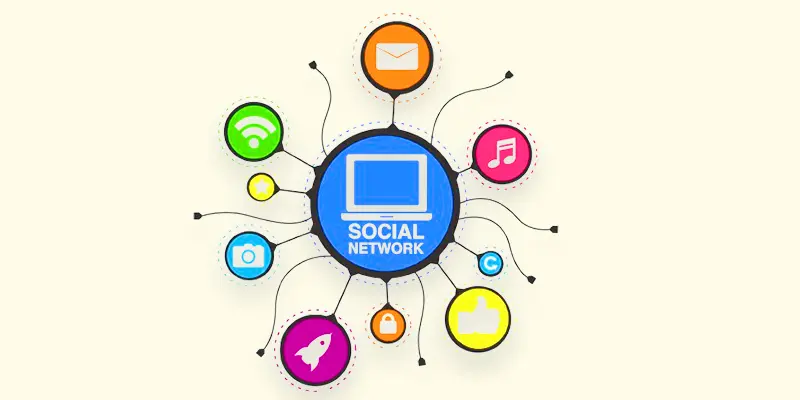Social Network | Definition, Examples, and Types
Published: 9 Sep 2024
What is a Social Network?
Any website or application that facilitates online connections is called a social network. It’s a place to share your thoughts, photos, and messages with friends, family, and even new people you meet. Social networks make it easy to stay in touch, join groups, and follow updates from people or topics that interest you. Social media sites like Facebook, Instagram, and Twitter are widely used.
What is Meant by a Social Network?
- An internet platform is called a social network.
- It helps people connect with friends, family, and others.
- You can share ideas, photos, and messages.
- It makes it easy to stay in touch with people.
- Examples include Facebook, Instagram, and Twitter.
Types of Social Network
There are different types of social networks, such as professional networks, interset-based networks, messaging networks, content-sharing networks, and more.
Social Media Network
Social media networks are online communities where friends, relatives, and others can be connected. Users can share updates, photos, and messages and see what others are posting. Examples include Facebook, where you share life events, and Instagram, where you post pictures and stories.

Professional Network
Professional networks are online platforms where you connect with others for career and job opportunities. You can showcase your skills, find job listings, and network with colleagues and industry experts. LinkedIn is a popular example, helping you build professional relationships and advance your career.
Interset-Based Network
Interest-based networks are virtual spaces where users can interact with others who have similar interests or pastimes. You can join groups, share content, and discover new things related to your passions. Examples include Pinterest, where you find and share ideas, and Reddit, where you discuss various topics with others with similar interests.
Messaging Network
Messaging networks are online platforms designed for chatting and sending messages. They let you text friends, make voice and video calls, and create group chats. Examples include WhatsApp, where you can message and call anyone globally, and Telegram, known for its secure and fast messaging features.
Content Sharing Network
Content-sharing networks are online platforms where you can post and discover various types of content like videos, articles, or photos. You share your own creations and view what others have posted. Examples include YouTube, where you watch and upload videos, and Medium, where you read and write articles.
Dating Network
Dating networks are online platforms where you create a profile to meet potential romantic partners. You can browse other profiles, send messages, and find matches based on your preferences. Examples include Tinder, where you swipe to connect, and Bumble, where you start the conversation.
Professional Development Network
Professional development networks are online platforms where you can learn new skills and advance your career. They offer courses, webinars, and resources to help you grow professionally. Examples include Coursera, which provides online courses, and Udemy, where you can find a wide range of professional training.
Community Network
Community networks are online platforms that connect people within a specific area or community. They help you share local news, events, and updates with neighbours and others nearby. Examples include Nextdoor, where you stay informed about your local neighbourhood, and local Facebook groups for community discussions and support.
Review Network
Review networks are online platforms where people share and read reviews about businesses, products, or services. You can see what others think before purchasing or trying something new. Examples include Yelp, where you read reviews for local businesses, and TripAdvisor, where you check reviews for travel destinations and hotels.
Collaborative Network
Collaborative networks are online platforms where people work together on projects or share knowledge. They help teams coordinate their efforts, track tasks, and communicate effectively. Examples include Slack, where you chat and share files with your team, and Trello, where you manage projects with others.
From USENET to Modern Social Network
- USENET: Started in the 1980s, it was one of the first ways people could share messages and discussions in online groups. It was mainly text-based and used newsgroups.
- Early Social Networks: In the 1990s and early 2000s, websites like Friendster and MySpace emerged, allowing people to create profiles, connect with friends, and share updates.
- Modern Social Networks: Today, platforms like Facebook, Instagram, and Twitter let people share photos, videos, and live updates with friends, family, and a wider audience, making communication faster and more interactive.
Telecommunication Network
- Telecommunications Network: This system allows people to communicate over long distances using various technologies.
- Components: It includes devices like phones, computers, and networks like the internet or telephone lines.
- Purpose: It helps people make phone calls, send texts, and access the internet.
- How It Works: Signals are transmitted through cables, satellites, or wireless connections to connect people and devices.
- Examples: Landline phones, mobile networks, and the internet are all part of telecommunications networks.

What is Network Access?
Network Access refers to connecting to and using a network like the Internet or a company’s internal network.
- Requirements: To access a network, you need the right hardware (like a computer or smartphone) and software (like a web browser or app).
- Authentication: Often requires login credentials like a username and password to ensure security.
- Purpose: Allows you to use network services such as browsing the web, sending emails, or accessing shared files.
- Network Access: It includes connecting to Wi-Fi at home, logging into a company’s VPN, and accessing a public network in a café.
The Online Experience
The Online Experience refers to everything you do and see when you use the internet.
- Browsing Websites: Looking at different websites to find information, shop, or read news.
- Using Apps: Using applications on your phone or computer for things like social media, messaging, or gaming.
- Watching Videos: Streaming videos on platforms like YouTube or Netflix.
- Communicating: Sending emails, chatting with friends, or video calling through apps.
- Interacting: Participating in online communities, forums, or social media to share your thoughts and connect with others.
Overall, it’s about how you interact with and enjoy the various digital tools and content available on the internet.

Conclusion about Social Network
Social networks are online tools that let people connect with others, share updates, and communicate. You can post photos, send messages, and see what others are doing. They come in different types, like personal networks for friends and family, professional networks for work, and interest-based networks for hobbies. Overall, social networks make it simple to stay in touch and interact with people around the world.
FAQS – Social Networking
What does a social network icon look like?
A social network icon is a small image or symbol that represents a social media platform. Facebook, for instance, uses a white “f” on a blue background as its mark.
How does a social network impact us?
Social networks impact us by allowing us to stay in touch with friends and family, share information, and discover new content. They also influence how we interact with businesses and the news.
Where can I find a social network icon in PNG format?
Social network icons in PNG format can be found on graphic design websites like Flaticon or IconFinder, where you can download them for free or purchase them.
What does a social network speech mean?
Social network speech refers to the way people talk or communicate on social networks, including the style, language, and types of interactions they use.
What are the different types of social network advertising?
Various forms of social network advertising include:
- Sponsored Posts: Paid content that appears in users’ feeds.
- Banner Ads: Visual ads displayed on the side or top of a social network page.
- Video Ads: Short video clips used to promote products or services.
- Story Ads: Ads that appear in the story sections of platforms like Instagram or Facebook.
- Influencer Partnerships: Collaborations with popular users to promote products.

- Be Respectful
- Stay Relevant
- Stay Positive
- True Feedback
- Encourage Discussion
- Avoid Spamming
- No Fake News
- Don't Copy-Paste
- No Personal Attacks

- Be Respectful
- Stay Relevant
- Stay Positive
- True Feedback
- Encourage Discussion
- Avoid Spamming
- No Fake News
- Don't Copy-Paste
- No Personal Attacks





